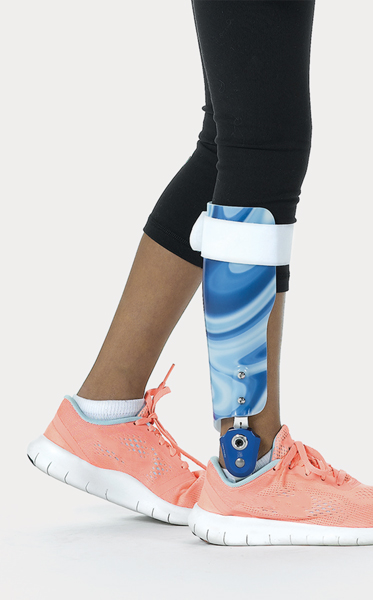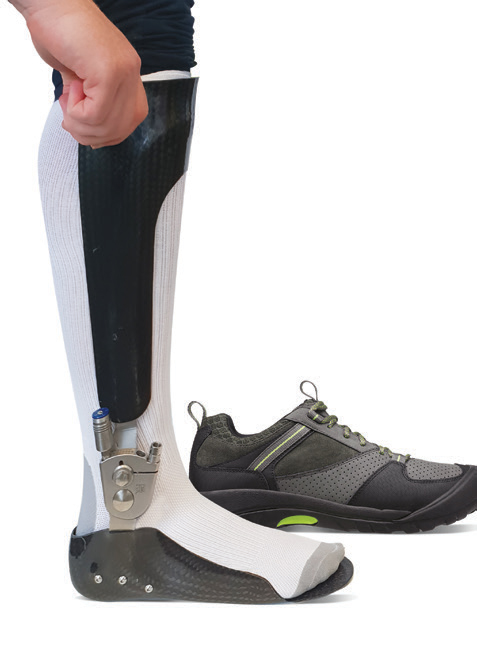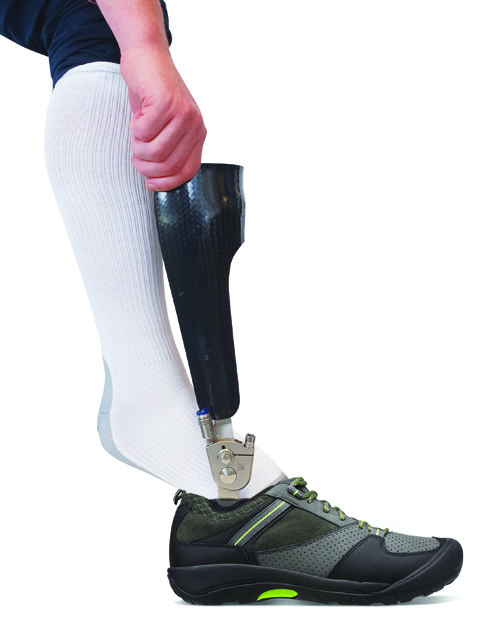Ankle Foot Orthoses (AFO) – A Guide for Patients
Introduction |
||
| Ankle Foot Orthoses or AFO’s can be custom made or prefabricated (ready made) and can be prescribed for many different conditions. Some of which include stroke, cerebral palsy, multiple sclerosis, paraplegia, polio, foot and ankle deformities and arthritis.
They are primarily designed to control movement at the foot and ankle and have various designs and features. Your Orthotist will determine which is the most appropriate for you. |
 |
|
AFO APPLICATION
Your Orthotist will have shown you how to put on and remove the orthosis at the time of fitting.
A plastic AFO should always be worn with a shoe, as it is extremely slippery, unstable and ineffective without one.
There are two preferred ways to don your AFO.
 |
 |
|
Example 1Place your foot into the AFO and fasten the straps and then put on the shoe. |
Example 2Slide the AFO into the shoe and using the device as a shoehorn, slip your foot inside. |
|
|
You will determine which method is more natural and comfortable. |
||
AFO Socks |
| Always wear a sock, stocking or similar garment under the AFO to reduce friction and protect your skin from perspiration.
Remember to keep your sock wrinkle free without putting pressure on the toes. Natural fibre socks such as cotton allow better air circulation, perspiration absorption. AFO socks are available to purchase in oapl clinics or online at www.oaplshop.com.au |
SHOES TO WEAR |
| Shoes worn with an AFO should provide sufficient support, slippers, sandals and loafers are inappropriate. Shoes, which are deep and have either laces or velcro (ie runners or walking shoes), are best.
Ask your Orthotist about which styles might suit you best. It is also important to maintain the same heel height for which the AFO was designed and patients should check regularly for signs of pressure and irregular shoe wear. |
 |
WEARING AN AFO
Your AFO has been made to fit you properly and provide the greatest degree of comfort. It may take a brief period before the sensation of wearing an AFO feels natural.
Follow your Orthotist’s advice regarding the length of time to wear the orthosis. It is recommended that you begin slowly and gradually build up the time that you spend wearing your AFO. This will ensure that your body gets used to the sensation of wearing the new device.
Please remember that it may take several visits to the Orthotist to ensure proper fit of the AFO.
A correctly fitting AFO exerts a firm, steady pressure. It should not cause a sharp stabbing pain, bruising, calluses or blisters. Should this occur, cease wearing the AFO and call your Orthotist immediately.
Please do not attempt to adjust the AFO yourself (This includes adding padding to the inside of the AFO).
Daily examination of the skin in contact with the AFO should become habit. A new AFO may cause some redness, which should disappear within 15 mins of removing the device. If the redness does not disappear cease wearing the AFO and contact your Orthotist.
People with diabetes and impaired sensation are especially vulnerable to skin irritation particularly in bony areas. Extra care should be taken and even minor skin irritations should be treated promptly. In the early stages of wearing a new AFO you should check your skin regularly for any irritation (approx every 1-2 hours).
MAINTENANCE
Cleaning Your AFO
It is recommend that you keep your AFO and yourself as clean as possible. Make sure your leg and foot are completely dry before wearing the device.
Care Instructions
1. The AFO should be cleaned regularly with warm soapy water and dried with a clean towel or left to air dry.
2. Do not soak your AFO in water or hasten drying by using a hairdryer or by placing it in front of a heater.
3. A light dusting of talcum powder can be used to prevent odours.
Maintenance
Big fluctuations in weight can affect the fit of your AFO. If this occurs contact your Orthotist. Growing youths should have their AFO’s checked at regular intervals to allow for rapid growth.
If any part of the AFO becomes cracked or broken do not attempt to repair it yourself. Contact your Orthotist who can arrange repair or replacement.
Worn fabric portions (ie straps) of your AFO should also be maintained. Fluff should be cleaned from velcro straps as required to ensure that they continue to grip adequately.
We suggest that you organise a review appointment with your Orthotist every 6 months to ensure your AFO is fitting correctly and providing you with adequate support.